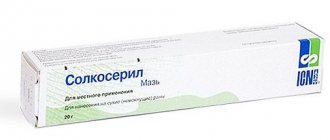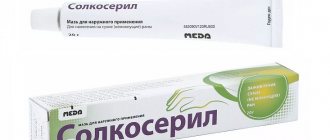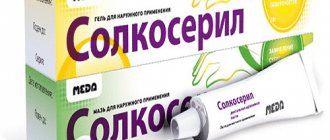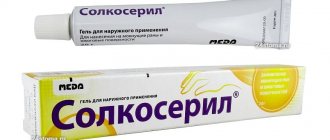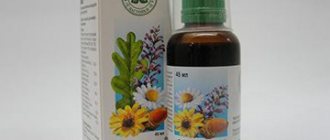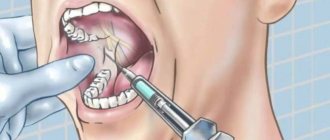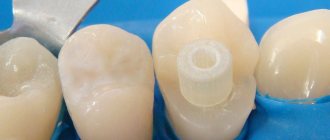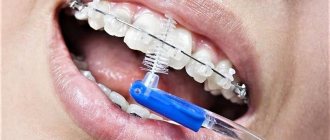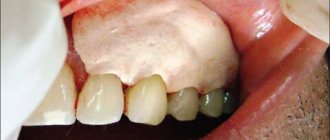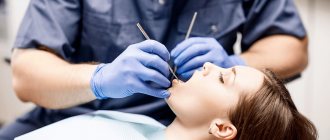Skin damage and wounds are always unpleasant. What can we say about trophic ulcers - companions of severe varicose veins, which are characterized by very sluggish and slow healing due to impaired tissue nutrition. Solcoseryl can help heal such difficult lesions, as well as burns, frostbite, and eye damage.
- Solcoseryl ointment as a face cream
- How to use Solcoseryl and Dimexide for wrinkles
In what forms is the drug available?
The manufacturer produces Solcoseryl in the form of ointment and gel for external use, as well as ophthalmic gel. In addition, this drug is available in injection form.
The active substance in all cases is calf blood extract - hemoderivat. Auxiliary components for each of the release forms are individual. Thus, in addition to the active substance, the solution contains only water for injection, and, for example, the manufacturer adds a number of ingredients to the ointment: white petrolatum, methyl parahydroxybenzoate, cetyl alcohol, etc.
Which is better: Metrogyl Denta or Solcoseryl
Both drugs can be used in the treatment of stomatitis. However, it is better to consider them not as drugs of choice, but from the point of view of a combination of two types of gels. The thing is that stomatitis is most often caused by bacterial infection of the tissues of the oral cavity, which causes the appearance of wounds and ulcers. Metrogyl Denta is an antimicrobial drug with a pronounced antibacterial effect. At the same time, everyone who has encountered stomatitis at least once knows how much one wants to speed up the healing process of ulcers that cause severe pain, especially when eating food. Solcoseryl can force tissue to regenerate as quickly as possible, which ensures prompt healing of wounds.
What kind of medicine is Solcoseryl?
The drug has a beneficial effect on tissue metabolic processes. It improves tissue nutrition in case of damage, and also activates repair and regeneration processes.
Solcoseryl in injection form is used for extensive circulatory disorders (diseases of peripheral veins and arteries, strokes), ointment and jelly are used to treat ulcerative lesions and slow-healing wounds, and the gel is an ophthalmic agent. Thus, each of the release forms performs its own task of restoring damaged tissue.
The rate of absorption and distribution of the drug in the body, as well as the route of its elimination, cannot be determined by methods usual in pharmacology due to the characteristics of the active substance.
According to the results of a study of the drug on animals, the pharmacological effect develops within half an hour after the bolus injection. The therapeutic effect lasts for 3 hours.
Solcoseryl dental adhesive paste 5g
Description
Light beige, granular, easily distributed homogeneous mass with the smell of peppermint.
Release form
5 g in aluminum tubes. The tube, along with instructions for use, is placed in a cardboard box.
special instructions
You should not put Solcoseryl dental adhesive paste into the wound cavity formed as a result of the removal of molars, wisdom teeth, as well as apicotomy (resection of the apex of the tooth), if the edges of the tooth socket are tightened with subsequent sutures. Solcoseryl dental adhesive paste does not contain anti-infective components. In case of acute infection of the affected area of the oral mucosa, which is subject to treatment with this drug, it is necessary to carry out preliminary medical treatment/treatment of the affected area aimed at eliminating the symptoms of inflammation.
pharmachologic effect
Solcoseryl is a deproteinized hemodialysate that contains a significant amount of low-molecular components of cells and blood serum of calves (dialysis/ultrafiltration, maximum molecular weight 5000 Da), the chemical and pharmacological properties of which are only partially described to date. A study of the drug on various cell and tissue cultures, organs, as well as animals showed that Solcoseryl: maintains and/or restores aerobic energy metabolism, as well as oxidative phosphorylation processes in cells deprived of sufficient nutrients, thereby maintaining and/or restoring supply of high-energy phosphates, increases oxygen uptake (in vitro), as well as glucose transport in hypoxic and metabolically depleted tissues and cells, improves repair and regeneration processes in damaged tissues and/or tissues deprived of sufficient nutrients, prevents and/or reduces secondary degeneration and pathological changes in reversibly damaged cellular systems, enhances collagen synthesis in in vitro models, and also stimulates cell proliferation and migration in vitro. Consequently, Solcoseryl dental adhesive paste protects tissues prone to hypoxia and/or substrate depletion. It stimulates the restoration of functions in reversibly damaged tissue, and also accelerates the healing of lesions and improves the quality of this process. Macrogol-9-lauryl ether (Polidocanol 600), a topical anesthetic, reversibly blocks peripheral nerve endings. Due to its high wetting ability, the analgesic effect occurs within 1-3 minutes after application. Due to the adhesive ability of the paste, this effect can last from 1 to 5 hours, depending on the location of the lesion and salivation. After swelling under the influence of saliva and wound secretions, the paste base, consisting of pectin, gelatin, sodium carboxymethylcellulose, liquid paraffin and polyethylene, forms an adhesive and elastic protective film on the wound.
Indications for use
Solcoseryl dental adhesive paste is used for local acceleration of healing, pain relief and protection of the wound surface in the following diseases and conditions: Treatment of painful and inflammatory processes of the oral mucosa, gums and lips (aphthae, labial herpes, gingivitis, periodontitis, stomatitis) Treatment of lesions caused by pressure of dentures on tissue (bedsores) Treatment of complications associated with the appearance of wisdom teeth Treatment of wounds after removal of tartar, curettage, periodontal surgery, tooth extraction and installation of immediate dentures Alveolitis.
Directions for use and doses
The drug is intended for local use in the oral mucosa. The affected surface of the mucous membrane must first be dried with a cotton or gauze swab. Apply a strip of paste about 0.5 cm long, without rubbing, onto the mucous membrane in a thin layer using a finger or a cotton swab, and then lightly moisten the applied paste with water. The procedure is repeated 3-5 times a day after meals and before bedtime. Treatment is carried out until symptoms disappear. Solcoseryl dental adhesive paste forms a protective healing layer on the affected area of the oral mucosa and protects it from mechanical and chemical damage for 3-5 hours. When applying the paste to undried mucous membranes, the duration of the therapeutic effect may be reduced. When treating bedsores from removable dentures, apply the paste to a dry denture and moisten with water. The recommended course dose of the drug is 1 tube (5 g). Special categories of patients Children The effectiveness and safety of the drug in children aged 2-5 years have not been sufficiently studied. There are no restrictions regarding the use of the drug in children over 2 years of age. There are no restrictions regarding the use of the drug in elderly patients.
Use during pregnancy and lactation
Animal studies have shown no risk to the fetus, but there have been no controlled studies in pregnant women. Caution should be exercised when used during pregnancy. There are no objections to the use of Solcoseryl dental adhesive paste during lactation.
Interaction with other drugs
To date, there have been no cases of interaction between Solcoseryl dental adhesive paste and other drugs. When simultaneously prescribing Solcoseryl dental adhesive paste and other drugs in the form of rinses, the paste should be applied after using these drugs.
Contraindications
individual sensitivity to any of the components of the drug (to preservatives - esters of parahydroxybenzoic acid (E216 and E218)), including free parahydroxybenzoic acid (E 210), the presence of a residual amount of which is due to the peculiarities of the technological process during the production of the drug. Infants and children under two years of age: Peppermint oil and levomenthol may cause spasm of the larynx, leading to serious breathing problems.
Compound
per 1 g Active ingredients: Solcoseryl (deproteinized dialysate from the blood of dairy calves), in terms of dry matter - 2.125 mg; polidocanol - 10,000 mg. Excipients: sodium carboxymethylcellulose, methyl parahydroxybenzoate (E 218), propyl parahydroxybenzoate (E 216), peppermint oil, menthol. Paste base: sodium carboxymethylcellulose, gelatin, pectin, polyethylene, liquid paraffin.
Overdose
There is no information on the effects of an overdose of the drug.
Side effect
change in taste sensations: allergic reactions (local swelling) are possible, if they occur, you must stop using the drug and consult a doctor. In rare cases (less than 0.01%), allergic reactions, in particular shortness of breath, may develop. In such cases, you should stop using the drug. May cause laryngospasm in infants and children under 2 years of age.
Storage conditions
Store at a temperature not exceeding 25°C. Keep out of the reach of children! The granular-dry consistency of the paste ensures its optimal adhesive properties and is not a sign of deterioration in the quality of the drug. When opening the tube, oil may be released, which is also not a sign of deterioration in the quality of the drug.
Buy Solcoseryl dental adhesive paste 5g in a pharmacy
Price for Solcoseryl dental adhesive paste 5g
Instructions for use for Solcoseryl dental adhesive paste 5g
Indications
For each release form of Solcoseryl there are individual indications.
In the form of injections, the drug is prescribed when a patient is diagnosed with:
- occlusive peripheral artery disease grade 3 or 4;
- disturbances of venous blood flow with trophic lesions;
- strokes and traumatic brain injuries, which led to disruption of metabolic processes in the brain.
Ointment and gel for external use are used in complex treatment:
- minor abrasions and wounds;
- mild to moderate burns, frostbite;
- difficult-to-heal skin lesions: trophic ulcers, bedsores.
Ophthalmologists recommend the use of Solcoseryl eye gel to patients for the treatment of:
- injuries of the cornea and conjunctiva, their erosive lesions;
- scars after ophthalmological operations;
- eye burns of various types;
- dystrophic lesions of the cornea.
In addition, this gel is indicated for use in case of discomfort when wearing contact lenses and to reduce the time of getting used to them.
How to minimize discomfort
You should start using antiherpes medications as soon as you feel a tingling sensation. Medicines will not get rid of the virus, but they will stop its development and speed up recovery. There are drugs that prevent the development of the virus: tablets, ointments for external use, which help heal blisters and ulcers and reduce discomfort.
When applying the ointment, use cotton swabs to avoid transferring the virus from your lips to the skin of your fingers.
Herpes requires the attention of specialists! A “cold” on the lips can be a symptom of serious diseases: a sharp decrease in immunity, cancer, HIV infection.
If you are suffering from relapses of herpes, consult a doctor. A specialist will not only save you from unnecessary worries and eliminate health hazards, but will also help you choose a comprehensive program for the prevention and treatment of herpes.
In order to make an appointment with an immunologist or dermatologist for a program for the diagnosis and treatment of herpes, call the Family Doctor clinic (clinic hours: Mon-Fri from 8.00 to 21.00, Sat-Sun from 9.00 to 20.00), or sign up for reception and diagnostics via online registration form
Side effects
The use of an injection solution in rare cases can lead to the development of allergic reactions, including anaphylactic shock. In this situation, you should immediately stop using the drug and prescribe symptomatic therapy in the form of antihistamines.
In addition, the process of performing the injection itself can be painful for the patient due to the potassium it contains.
When using the ointment, some patients may experience a burning sensation at the site of application.
Solcoseryl eye gel may cause short-term irritation, which is not an indication to discontinue treatment. The development of allergic reactions when using external forms of the drug is extremely rare.
Mode of application
Solution
Solcoseryl in the form of a solution is recommended to be administered intravenously slowly in the form of an injection or by drip, having previously diluted it with saline solution or 5% glucose solution. If intravenous administration is difficult, intramuscular injection is allowed.
For the treatment of venous insufficiency, the drug is prescribed for up to a month, combining it with the application of an external gel or ointment to the area of trophic ulcers.
Patients who have suffered a stroke are prescribed a course of treatment with Solcoseryl for 5 weeks. When treating traumatic brain injuries, short courses lasting 5 days are prescribed.
Ointment and gel
Ointment and gel for external use are applied directly to the wound. Before using them, the wound surface is thoroughly disinfected. In the presence of purulent discharge, surgical treatment may be required.
The gel is used to treat wet, fresh wound surfaces. When the affected area begins to epithelialize, granulation tissue appears and the wound dries out, you should switch to using Solcoseryl in the form of an ointment.
The course of treatment with external forms of the drug is carried out until the wound surface is completely healed and a scar is formed.
Ophthalmic gel
The eye gel is instilled into the conjunctival cavity 3-4 times a day, one drop at a time. In some cases, it is possible to use the drug hourly. The course of treatment lasts until complete recovery.
Pharmacological action of the ointment
The pharmacological properties of the drug have not been fully studied. However, during the studies it was proven that solcoseryl has the following properties:
- in case of oxygen deficiency, its delivery to damaged cells is ensured;
- glucose transfer in metabolic disorders;
- is a catalyst for the formation of intracellular ATP;
- ensures the storage of energy in mitochondria generated during the transformation of nutrients;
- supports cells during nutritional deficiencies by supplying high-energy phosphates;
- prevents or prevents atypical changes with minor cell damage;
- “launches” the process of natural restoration of cells and tissues;
- activates the proliferation (division and formation) of fibroblasts that form the framework of connective fibers, and the formation of collagen filaments in the walls of blood vessels.
The ointment is widely used in cosmetology, gynecology, ophthalmology, and dentistry.
Main indications for use of the product
Ointment with solcoseryl is recommended for:
- minor skin damage in the form of abrasions;
- burns (except chemical) 1-2nd degree, which occur without the formation of exudate;
- frostbite of the 1st-2nd degree in the absence of wound weeping;
- psoriasis;
- to eliminate dry calluses and corns;
- to prevent the formation of scars after laser removal of warts or moles;
- atopic and seborrheic dermatitis;
- “sticking” in the corners of the mouth;
- drying of the nasal mucosa;
- in the treatment of wounds that heal poorly, including trophic ulcers and bedsores, after removal of dead tissue.
As a rule, a gel with solcoseryl is first applied to treat the wound surface with the separation of exudate. After the first signs of wound granulation appear, therapy is continued with the drug in the form of an ointment.
Differences between the ointment form of solcoseryl and the gel form
Pharmacies offer 2 forms of the drug intended for external local use. How do they differ and is it necessary to pay attention to such nuances?
The main differences between the forms are due to the excipients. Thus, solcoseryl gel does not contain fatty bases, which is why it is quickly washed off with warm water and removed from the surface of the skin. Due to this, it is the gel form that stimulates the formation of granulation tissue and the elimination of wound exudate.
When the wound dries out and signs of granulation appear, it would be more appropriate to use ointment. The fatty base of the drug forms a protective film on the surface of the wound, so the healing process is noticeably faster. In addition, solcoseryl ointment softens the surface of the wound, thereby avoiding the appearance of scars and other skin defects.
